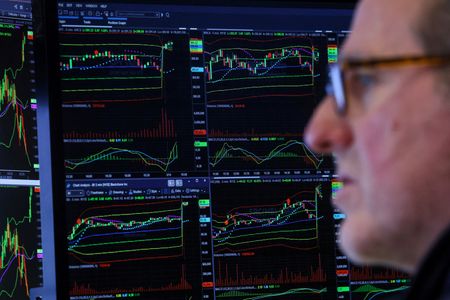By Yoruk Bahceli
(Reuters) – Bond investors could be in luck for the rest of 2023 if market indicators signalling central banks will take policy tightening too far and tip their economies into recession prove accurate.
Headline inflation has eased but underlying pressures remain high, keeping central banks hawkish. Canada resumed tightening and Britain and Norway made big moves in June, while U.S. Federal Reserve and European Central Bank officials at last week’s Sintra forum signalled more rate hikes.
Markets now anticipate a 25 basis point Fed hike, probably in July, and see a 30% chance of another by November, and have reduced the number of cuts they expect next year.
They are pricing in two more ECB hikes to 4%, a change from the single hike to 3.75% they foresaw earlier in June, while the Bank of England is expected to raise its main rate near to 6.25%, much more than the 5.5% previously expected.
Along with those bets, yield curve inversion – where shorter-dated bonds offer higher yields than longer-dated ones, seen as a good sign that investors expect a recession – has deepened as yields on shorter maturities surge.
U.S. 10-year Treasuries are yielding 104 bps less than two-year peers, the most since March’s banking sector mayhem and almost their deepest inversion since the 1980s.
Similar patterns can be seen in German and British debt.
“What the yield curve is telling you is that this is extremely tight monetary policy,” said Mike Riddell, senior fixed income portfolio manager at Allianz Global Investors, which manages 514 billion euros ($558.31 billion) in assets.
“We are positioned for a very big bond rally, and we think that risky assets are completely underestimating the risk of a recession or something nasty happening,” he added.
“I am essentially positioned for this being a policy error.”
BETTER YEAR
A policy overstep that central bankers had to reverse would be good news for investors in global government bonds, who CFTC data shows have piled up bets that U.S. bond prices will fall.
That means any turn in sentiment could lead to a big rally, boosting returns that have been less than 2% year-to-date after a 13% loss last year.
An early sign that the bond outlook is improving came last week with data showing euro zone business growth stalled in June. In response, German bond yields, which move inversely to prices, posted their second biggest daily drop since March.
But highlighting how hard economic data has become to read, higher-than-expected U.S. first quarter growth and German inflation sent yields surging on Thursday.
Investors on alert for a policy mistake fear that central bankers are basing their decisions on inflation and other backward-looking data that aren’t yet showing the full impact of previous hikes, and overlooking signs of pending disinflation.
One indicator in focus is producer price inflation, seen as a harbinger of broader inflation. It dropped to 1% annually in Germany and 2.9% Britain in May, the lowest in over two years, and has dropped similarly in the United States.
“We all made a big deal this time last year when (producer price inflation) was on the way up. But it seems like it’s being ignored on the way down,” said Vanda Research global macro strategist Viraj Patel.
Deutsche Bank says the Fed may be “overcompensating” for starting rate hikes too late, pointing to improvements in the labour market, signs of a pending fall in rent inflation and tightening bank lending standards.
Such forward-looking figures suggest economic data could turn quite sharply, Vanda’s Patel said, adding that across big economies, every hike now raised the chance of a policy error.
Major central banks fighting a surge in inflation have collectively raised borrowing costs by over 3,750 bps since September 2021.
TRICKY
Josefine Urban, portfolio manager at Britain’s biggest investor, Legal and General Investment Management, said she favoured bets that British government bonds would outperform U.S. and German peers.
The 10-year yield on UK Gilts has surged 75 bps to 4.43% this year, while yields on U.S. and German equivalents hardly moved.
“We do think that given (the BoE) are … mainly focused on lagging data, so they’re looking at inflation data, wage data, the labour market, there’s quite a big risk that they do over-tighten and that we will then get the recession,” Urban said.
Forecasts aren’t always right: late in 2022, 60% of economists polled by Reuters expected a U.S. recession this year, but none has yet materialised and risk assets that would be hit by one have barely blinked.
But even those not betting on a contraction are cautious.
“Our base case is not that we’re going to get a recession but the risks are definitely growing,” said Jill Hirzel, senior investment specialist at Insight Investment.
Central bankers’ “priorities have been made very clear that if the risk is a recession, they’re okay with that to bring inflation down,” said Hirzel, adding she favoured investing in defensive sectors and higher-rated corporate bonds.
($1 = 0.9206 euros)
(Additional reporting by Dhara Ranasinghe and Harry Robertson; Editing by Dhara Ranasinghe and Catherine Evans)






